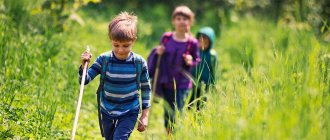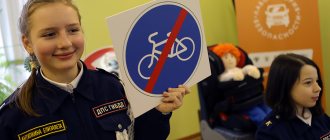Presentation-photo report “Formation of the fundamentals of safety in preschool children”
Svetlana Pirozhenko
Presentation-photo report “Formation of the fundamentals of safety in preschool children”
«Formation of safety principles in preschool children».
teacher: Pirozhenko S. L
Preschool age is the most important period when personality is formed foundations of life experience and a healthy lifestyle are laid.
Children from a very early age should know safety , as they may find themselves in unpredictable situations on the street, at home, in nature, on the road, so the main task of adults is to develop independence and responsibility.
The task of us, teachers and parents, is not only to protect and protect the child, but also to prepare him to face various difficult and sometimes dangerous life situations. Work experience shows that only those who obtain the necessary knowledge about existing dangers, learn to recognize them in a timely manner, avoid them, contain them and reduce them can help themselves in a difficult situation.
We take the very first steps in teaching educational institution. Having chosen different types of activities, we take into account the fact that they will influence to varying degrees the development of different aspects of the child’s personality, and will also facilitate the perception of the problems and knowledge presented. By equipping children with certain knowledge, skills, abilities, and cultivating certain useful habits, among which the development of healthy lifestyle habits is of decisive importance, we, teachers, take the first steps in raising a healthy child.
From an early age, a child interacts with the world around him. He will know it. But not everything in the world around the child is clear and safe . Our task is to protect the lives of children by equipping them with basic knowledge and skills that will help them find a way out when encountering unfamiliar phenomena in the world around them and survive in it.
To implement the tasks of educating safe behavior in preschoolers, we use various forms children’s activities :
reading fiction "Cat's House"
,
“The Wolf and the Seven Little Goats”
,
“Kolobok”
, examination of illustrations on the topic of
safety .
We instill in children the observance of basic rules of obedience.
didactic games, role-playing games,
theatrical activity
Introduction to transport, traffic lights, pedestrian crossings and their meaning.
security house that contains materials: various types of sockets, switches, locks
Since the leading activity of a child in preschool age is play , one of the main methods of health-saving education of children at this age is the play method.
Play is an effective means of developing a preschooler’s versatile personality , his physical, mental and spiritual potential. Games , varied in content and , introduce the child to the circle of real life phenomena, ensuring the unintentional development of the social experience of adults: knowledge, methods of action, moral norms and rules of behavior, assessments and judgments.
In order to teach children to live safely , we have created a subject-based development environment in our children's educational institution. It includes the “ Safety ”
Board and printed games “ Safety Fundamentals ”
,
“Walk around the farm”
,
“Good - bad”
,
“Road signs”
,
“Emergencies at home”
.
Attributes for plot-role-playing games, folders - moving
Library
which contains educational and fiction literature, photo albums, illustrations for viewing and discussing various situations.
Working with parents is one of the most important areas of educational work in preschool educational institutions. Therefore, close contact with parents is necessary, because they are interested partners, active assistants in working with children in this area.
Nothing educates as convincingly as the clear example of adults.
Work results:
- children have grown a steady interest in life safety classes;
- increased experience of safe behavior ;
- demonstrates independence, responsibility and a conscious attitude towards the rules and norms of safe behavior in various situations at home and on the street;
- vocabulary is replenished;
-established close contact with parents.
safety of preschoolers at home and in kindergarten presentation for a lesson on life safety (junior group)
Slide 1
Municipal budgetary preschool educational institution general developmental kindergarten No. 110 Consultation for parents “Safety of preschoolers at home and in kindergarten” Completed by: Oksana Sergeevna Krivoborodko, Voronezh 2022
Slide 2
Among the many knowledge that a person needs, the science of safety is one of the very first. People came up with it when they were still living in caves. To protect himself from wild animals and cold, man learned to make fire and make weapons. People built cities with large houses that were no longer afraid of rain and frost. Life has become easier today. But there are still many dangers in it. This, of course, does not mean that you should be afraid of everything in the world. The Russian people have a proverb: “A scared crow is afraid of a bush.” But courage should not be imprudent. You need to know how to deal with dangers in order to be able to protect yourself. It is important that our students learn to apply in practice and in real life everything that they were taught during an important period - during preschool childhood!
Slide 3
But it does not happen that danger arises immediately, out of nothing. Any of the unpleasant events would not have happened if their participants knew the main rules of safe behavior: Anticipate danger. Avoid it if possible. Take action if necessary. In early preschool age, the implementation of these rules falls entirely on the shoulders of adults. Who is responsible for the safety of a preschool child? The answer is clear - parents, which naturally does not exclude the delegation of their responsibilities to a nanny, preschool teacher and other persons. Parents should always assess the potential danger to the child in a particular place and make every effort to reduce it. Perhaps this will be a revelation for someone, but even if your child is in kindergarten, with a beloved grandmother or friend, this does not relieve you of responsibility for him.
Slide 4
Your task is to ensure maximum protection for your child at home and outside, and be ready to quickly respond to any problems that arise. Your child should know the basic rules of safe behavior, which include such subsections as “I and the world around me” - knowledge about myself, “Fire safety hazards”, “Rules of behavior in a team”, “Behavior on the water”, “Safe behavior” in the house" - dangerous places and objects; "Safety on the street" - strangers, aggressive animals and other dangers. In kindergarten, starting from the middle group and more in-depth in the senior and preparatory groups, life safety classes, games, targeted walks, theatrical performances are held, with the help of which adults, without moralizing or edification, introduce the child into a world that is fraught with so many surprises.
Slide 5
And those who temporarily take care of your baby should understand what “Safety of Preschool Children” means. They should know your child’s characteristics: what he shouldn’t eat, what to keep him interested in, and what his habits are. They must know how to quickly contact you in case of an emergency, and you, in turn, must be always in touch. And, of course, you yourself must be familiar with the safety rules for a preschooler. The requirements in kindergarten and at home must be the same. How to effectively ensure the safety of a preschooler? Practical advice for ensuring the safety of preschool children. There are not many of them, only three, but this is the basis of any security:
Slide 6
• All potentially dangerous places in the house for a preschool child should be protected as much as possible. A simple rule, but often ignored. Open windows, stoves, electrical outlets, and so on can be deadly for your baby if you turn away for even a minute. Remember, the phrase “you can’t protect yourself from everything” is NOT an excuse; in this case, it’s better to overdo it than to bitterly regret it later. Moreover, today there are many methods of protection. For example, an effective means of controlling access in an apartment is a security gate, which is installed in doorways or attached to random places on the walls. And for local protection of dangerous places, you can use caps on stove handles, blockers for windows and ovens, plugs for electrical outlets and protective corners on sharp edges of furniture.
Slide 7
By the way, tall furniture that can fall (for example, a small cabinet) must be securely fastened to the wall, the same applies to tall objects such as a Christmas tree; • A small child should never be left alone with potentially dangerous objects. By the way, these include many toys. Small parts, chemicals (glue, paint, plasticine, sharp, hot or heavy objects can cause significant harm. Remember that even ordinary household chemicals that you use to wash dishes, if the substance is swallowed (for example, a child puts a sponge soaked in it into his mouth) ) can cause a serious chemical burn to the baby's mouth and larynx. And a hot pan placed on a table with a tablecloth poses an even more real threat to the baby. After all, he can pull the edge of the tablecloth and be scalded by the contents of the pan. The phrase “I left my three-year-old son with his five-year-old sister and thought that everything would be fine” - this is a crime against one’s children.
Slide 8
This also applies to walks on the street, where there are large dogs, adults with an unhealthy psyche, there may be fragments of bottles on the ground, and so on. When walking outside, try to be at such a distance from your baby that you can clearly see what he dug out of the ground or what is nearby; usually this distance should not exceed two meters. Do not forget that even a modern playground, made according to all new safety standards, can pose a threat to a child, for example, from a swing, the impact of which can cause serious physical and psychological trauma to the child; Always communicate basic safety rules clearly to children. But always consider their age. If you tell a two-year-old “don’t go into the socket, there is current,” then at best he will NOT understand you, and at worst he will omit the negative particle “not” and just go into the socket.
Slide 9
Didn't you know that children ignore negative particles? In general, keep in mind that each age and level of perception should have its own methods of teaching safe behavior.
Slide 10
Memo for parents What a preschool child should know about safety • A preschooler must understand the very essence of the concepts: “dangerous” and “safe” - understand that there are dangerous people, objects, and natural phenomena. Understand the essence of health and damage to the body. Know general information about yourself (last name, phone number, etc.). • The child must know the basic safety rules when staying at home, including fire safety rules - the danger of playing with flammable objects, calling the fire department, etc. And also the danger of sockets, hot objects (iron, stove, heater, open windows, talking on the phone with strangers, opening the door to strangers, etc. •
Slide 11
A child of preschool age should know the basic safety rules when being on the street - that you should not pick up syringes or sharp objects, such as broken glass, from the ground, talk and go somewhere with strangers, approach large dogs, climb high on fences and trees, etc. A preschooler must know the rules of safe behavior in kindergarten. Behavior in a group with children, movement around the kindergarten, going outside, games, rules for handling objects that may pose a danger to others. • The child must learn the main dangers that may await him and the rules of behavior in these situations. These are man-made hazards (fires, electric shock, gas poisoning from a stove, etc., natural hazards (earthquakes, lightning strikes, hurricanes, etc.) - special emphasis should be placed on phenomena inherent in the area.
Slide 12
• The child must know the basic rules of the road and basic traffic signs, for example, “underpass”, “overground crossing”, “ground crossing”, “pedestrian path”, etc. • The preschooler must understand the rules of behavior in basic situations: “ in the sun”, “on the water”, “on the ice”, etc. • A preschool child should know the general rules of healthy eating and conditioning the body. Understand what is useful for him and what is not. • The child should have a general understanding of environmental protection and how best to protect nature. Take care of your children, because the most precious thing in our lives is the lives of our children! •





